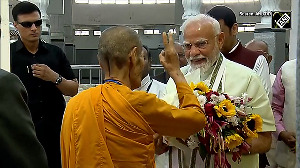This may lead to the states' combined fiscal deficit to widen much faster, while the Centre may show a smaller or insignificant slippage in meeting its deficit target.
The Centre will celebrate over its fiscal prudence, but the states would suffer, A K Bhattacharya points out.

The Union government's finances are routinely analysed and critically appraised, when its revenue and expenditure data are released by the Controller General of Accounts at the end of every month. These are unaudited and provisional numbers, but they do provide a broad idea about the state of the Centre's finances.
But little analysis of the state governments' finances takes place during the year. This is unfortunate. A reason could be that there is no centralised agency that compiles the data on finances of all the 30 states and makes them available on a monthly basis.
The Reserve Bank of India does bring out a study of state budgets, but that being an annual publication becomes slightly dated.
Since the last 10 years, the combined size of state budgets has been higher than that of the Centre's budget. The size of state budgets exceeded that of the Centre's budget for the first time in 2011-2012 by about 4 per cent.
In 2020-2021, the state budgets were about 22 per cent more than what the Centre spent. Therefore, what the states do with their expenditure or with their revenue plays as important a role in the economy as the Centre's budget.
For instance, when governments are expected to spend more during or immediately after a pandemic, the focus is largely on the Centre's expenditure pattern. Little attention is paid to the states, whose expenditure size has more firepower.
When the latest information on state budgets is not easily available and, therefore, cannot be used as an input for analysis, tracking the impact of only the Centre's revenue or expenditure on the economy becomes deeply flawed.
The data for the Centre's revenue and expenditure are available for the first five months of 2021-22. But only about 20 states have so far released their unaudited and provisional budget data for April-August 2021. These cover all the major states except West Bengal, Bihar, Assam, Delhi and some of the smaller states, including a few in the north-east.
The total expenditure size of these 20 states for the full year of 2021-2022 is Rs 34.4 trillion, marginally lower than the Rs 34.8 trillion, which the Centre is expected to spend during the year. But a quick analysis of the way these 20 states spent and collected their revenue in April-August 2021 shows how different their approach to budgeting is from the Centre's.
One, these states have been far less stingy with their overall expenditure than the Centre. In April-August 2021, their total expenditure grew by 13 per cent over the same period of 2020 and by 11 per cent over the same period of 2019.
In contrast, the Centre increased its expenditure only by about 2 per cent over the last year and by 9 per cent over 2019. The Centre had, however, spent more in April-August 2020, in the middle of the first wave of the pandemic, compared to the states.
Against the Centre's 6 per cent rise in its total expenditure, the states' spending had contracted by 2 per cent in April-August 2020. The rise in the states' spending is contrary to the general impression that the states squeezed their expenditure in the first five months of the current year.
But the worry is that the bulk of the rise in the states' spending this year is on account of higher revenue expenditure.
These states' revenue expenditure in April-August 2021 went up by 9 per cent when compared with the same months of 2020 and by 12 per cent, when compared with the same period of 2019. In contrast, the Centre has kept a tight leash on its revenue expenditure, which contracted by about 1 per cent year-on-year and rose by just 6 per cent over the same period of 2019.
On the capital expenditure front also, the Centre's performance has been far better. The contraction in its capital spend in April-August 2020 was far less than that of these 20 states.
This also meant that while year-on-year, these states showed an impressive increase in April-August 2021, that increase was only 10 per cent when compared with the same months of 2019. The Centre's capex showed a higher growth rate of 26 per cent over the two-year ago period.
Two, an even more remarkable contrast between the Centre and these 20 states is apparent with respect to collections of tax revenue.
The contraction in tax revenue for both the Centre (net revenue) and these 20 states (own tax revenue) was about 30 per cent in April-August 2020, thanks to the economic lockdown during this period.
But their performance in the same months of 2021 is starkly different -- the Centre's net tax revenue grew by 127 per cent, while the own tax revenue of these 20 states rose by just 52 per cent.
Worse, the share of these 20 states in Union taxes continued to fall. It fell by 14 per cent in April-August 2020 and by another 4 per cent in the same period of 2021.
This brings out quite an ironic picture.
The states have relatively performed poorly in collecting revenue, but are spending more, particularly on the revenue account.
But the Centre is making huge gains on revenue both through its own collections as also because of the reduced transfer to the states.
Yet, the Centre is not loosening its purse strings as its overall spending remains under control and the only sizeable increase is in its capex.
In the end, this may lead to the states' combined fiscal deficit to widen much faster, while the Centre may show a smaller or insignificant slippage in meeting its deficit target. The Centre will celebrate over its fiscal prudence, but the states would suffer.
But those tracking the Indian economy do not look at the Centre's numbers alone. They judge the combined fiscal performance of both the states and the Centre.
An early diagnosis of the slippage in the states' fiscal performance should help.
But the first task should be to ensure that all the states' budget data are released with the same monthly frequency as has become the practice for the Centre.












 © 2025
© 2025